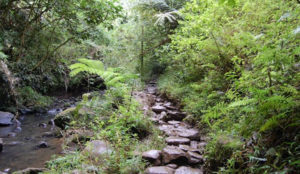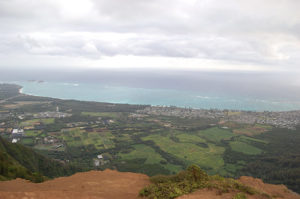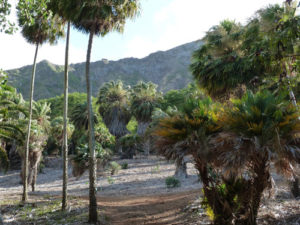Diamond Head, Punchbowl and Koko Crater are the more notable volcanic craters on Oahu. Inside Diamond Head are military facilities, inside Punchbowl is a war memorial and cemetery, but what lies inside Koko Crater?
This conundrum led me to a small dirt lot at the end of quiet Kokonani Street on the southeastern side of the island. Instantly the air is sweet and the eyes are greeted by a rolling vista of abundant green speckled throughout with generous bouquets of plumerias. It’s a plumeria grove, resplendent with dozens of varieties. Some are thick-petaled like floppy bunny ears, others are slender and spidery.
Some are delicate and white and others are hearty and radiant in yellow, orange and bright pink. I bury my face in the cooling, lush petals of each tree to get a breath full of its unique scent.
This is the Eden-like gateway to a two-mile loop trail through Koko Crater Botanical Garden. Lining the wide pebble-strewn dirt road is flora that flourishes in the hot, dry climate. The garden is labeled with sections.
Bougainvilleas thrive in burgeoning mounds of purple and hot pink on the hillside as you approach the Pacific section.
Here, hybrid hibiscus and hala trees are featured, the latter having a prime feature in Hawaiian history, their leaves having been used in weaving mats and baskets.
Seemingly out of place and rather Dr. Seussian in its silhouette of gnarly shapes is the cactus garden of the Americas.
I like this garden, yes I do, with its green balls that dot the ground. They dot the ground like basketballs.
I like the tall ones, yes I do, and the limp and snaking ones very much too.
I like them all covered in bristles, I like them, like them even when they’re not.
I like the green flower ones that make you think “tequila,” and the big springy tufts that scream pineapple head.
I enjoy them and you will too.
You will like them in the sun, you will like them in the shade.
You will like them with your kids, with your date or with your mom.
You will like it, yes you will, this surreal garden inside a cinder tuff cone.
A pamphlet at the entrance to the crater explains that it was formed 100,000 years ago of tuff or fine ash that solidified into cinder before becoming rock. Positively Jurassic is the landscape of African palms with their giant leaves fluffing out in bushy bunches, some close to the ground, others contrasted against the sky atop their long stalks. Also in the African section are mammoth baobabs with their swollen trunks that taper into a humorously small upper section.
A trail leads into the palm forest where benches and picnic areas welcome guests to retreat from the dry heat of the easterly sun. Rest areas are here and there throughout the entire loop as well, and the trees lining the path offer plenty of shade.
The garden is open from sunrise to sunset and going in the early morn or late afternoon is utterly pleasant, and avoids the brutal midday heat. No matter when you go, the crater is a place of solitude with bird calls, whispering winds, and a rare strolling exerciser or family crossing your path.
Rounding the bend back toward the beginning of the trail is an area with unusual plumeria cultivars that boast up to 10 petals. From one such tree grows clusters of these “monster” flowers from some of its branches and normal clusters on others ? a new conundrum to keep me curious. Keep walking and you return to that paradise of plumerias with its myriad bushy trees ablaze with luscious clumps of flowers in every color of the setting sun.
Hundreds more festively sprinkle the ground, like you’re being welcomed to a perpetual honeymoon.
- Trail: Koko Crater Botanical Garden
- Length: 2-mile loop
- Directions: Coming from Waikiki on Kalanianaole Highway, pass Hanauma Bay, turn left onto Kealahou Street, and left again onto Kokonani Street, which dead-ends at the botanical garden.








